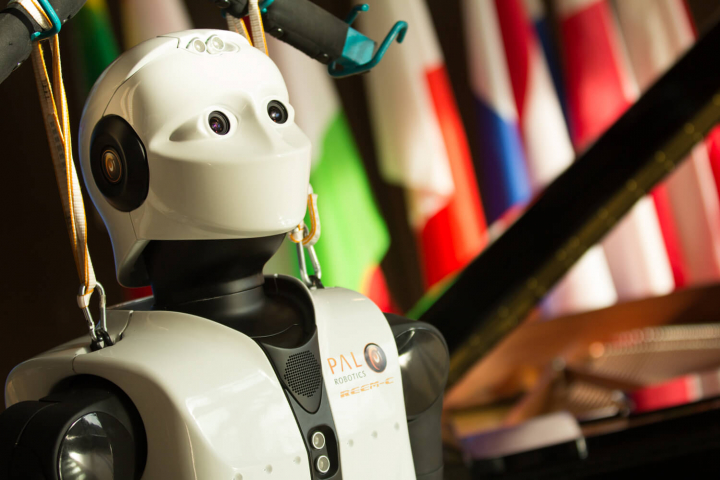
Robots are often seen as mythical creatures with super-human abilities. They have a firm place in the consciousness of almost everyone, less than a century after the word robot was coined by Karel Čapek in his play R.U.R. in 1920. However, automata have been made for thousands of years and the idea has been around for at least as long. In reality, robots are simply machines that sense their environment, and perform actions in response. What makes them special, compared to a desktop computer or smartphone, is their physical “body” which interacts with the real world. Let’s explore some myths about robots…
Myth 1: Robots are only found in science fiction stories
Robots are already impacting the way we work, live and explore new frontiers. It’s expected that 2.6 million industrial robots will be used in factories around the world by 2019 to increase productivity and take on dull and repetitive tasks (source: International Federation of Robotics - IFR). Nearly 3 million drones provide an eye in the sky to inspect infrastructure, map disaster sites, take aerial shots, and why not a selfie drone (source: Gartner). 31 million domestic robots will be helping with chores around the house like vacuuming, or for entertainment (source: IFR). Doctors are now working with surgical robots to perform minimally invasive surgery. And the news regularly reports on the exploits of robots exploring the deep sea, or even other planets. So while many people don’t own a robot, their presence is increasing rapidly.
Myth 2: There is a clear definition of a robot
There is no common definition of a robot. A robot is typically a machine controlled by a computer that is used to act and perform jobs automatically. It can be fixed at one location while having movable parts or is able to move within a certain environment. It may be able to adapt its behaviour and actions to its environment and may be able to learn from experience as well as by interaction. In our context, a robot is always designed to interact with the environment in a physical way. For purely software-based systems, the word softbot or AI system is more appropriate.
Myth 3: Europe doesn’t make robots
Europe has one of the largest funding programs in the world for robotics called SPARC with 2.8 billion EUR invested from the European Commission and industry (www.sparc-robotics.eu). The focus is on making robots that work alongside humans to solve societal challenges. In industry, projects like Co4Robots are making collaborative robots (co-bots) that interact with operators to provide services such as object handling/ transportation, or pickup and delivery. Autonomous cars will make roads safer and greener, while saving hours behind the wheel. The project Dreams4Cars for example helps cars develop safe behaviours in the case of rare events, including near miss car accidents. Agriculture robots will allow farmers to grow more food with less waste. Projects like Flourish develop adaptable robotic solution for precision farming, while the Sweeper project demonstrated a pepper picking robot. Prosthetics and exoskeletons will help people with disabilities regain their mobility. In the CYBERLEGs project, powered robotic orthoprosthesis helped restore mobility to amputees and the elderly. Helping ageing populations stay in their homes is also the goal of the MoveCare project which is building a multi-actor platform to support independent living by monitoring, assisting and promoting activities to prevent decline.
Myth 4: Robots should look like human
Most robots used today look nothing like humans. Making robots is hard, typically requiring years of research to design the right hardware and software. As a result, they are engineered to perform very few tasks well, rather than many different tasks - they are specialists, not generalists. So if you were expecting a humanoid to drive your car and vacuum the house, guess again, you’ll probably end up with two different robots that are designed just right for the task, and they don’t need to look like a human.
Myth 5: Making robots is a solved problem
After seeing videos of humanoids running through a forest, or of thousands of drones dancing in the sky, you may think the art of robot-making has been mastered. Yet, for robots to reach their full potential, many advances are needed in fundamental science. They need better cognition to understand the world around them, and interact with humans in a natural way. New materials could make them softer, lighter, and safer to work with. Smart sensors could help them perceive their environment with higher precision. And new batteries or other energy sources are essential for them to operate for long periods of time.
Myth 6: Robots will destroy society
With media headlines featuring stories of robots taking jobs, and science fiction playing with fears of robots going rogue, there is concern about how robots will impact society. Key will be to ensure that robots are developed to help society flourish. This is currently being addressed by many European governments, in 2017 the European Parliament passed a bill on the “European Civil Law Rules in Robotics”. Many efforts around the world are also focusing on providing clear standards to help make ethical robots that benefit society.
Myth 7: Robots are made only by engineers
Robotics is very cross-disciplinary. Whether you’re a programmer, engineer, material scientist, lawyer, social scientist, designer, or philosopher, we need your help to make the robots of tomorrow. And if you’re in a field where you think robots could be helpful, then let us know! The European Robotics Week is a great way to engage with the robotics community with around 1000 events for every age all over Europe (www.roboticsweek.eu).
This work has received funding from the European Union’s Horizon 2020 Programme under the RockEU2 project, grant agreement n° 688441.